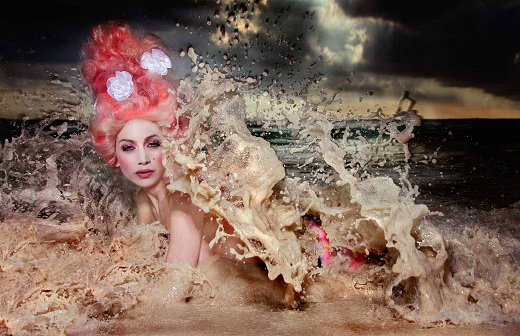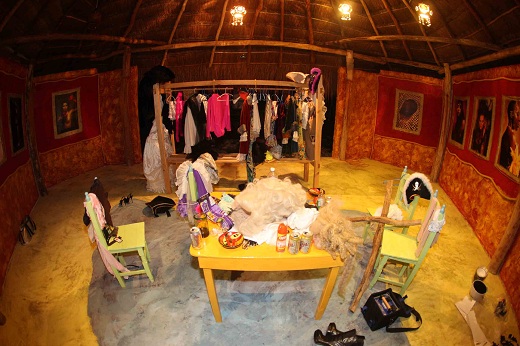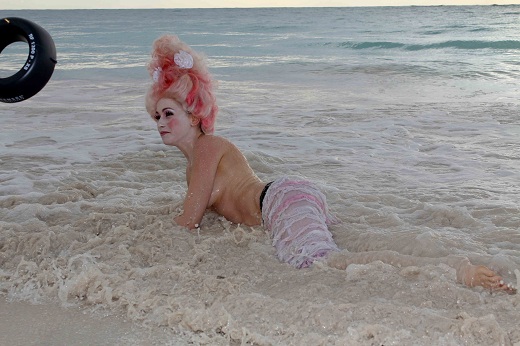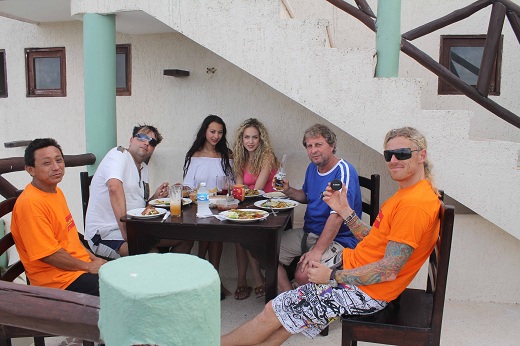The Shot: La diosa de las olas
This article is written by a member of our expert community. It expresses that member’s views only. We welcome other perspectives. Here’s how to contribute to MM EDU.
On May 26th, 2011 I had an opening of my new exhibition called Teatro Caribe. I presented 21 large format photographs, shot especially for this exhibition on the beautiful beaches of The Riviera Maya and other exotic locations in the area.
From the very beginning of the project I was certain about the style of the photos. My concept was to shoot provocative glamour photos in a decadent way, using original baroque styling. It gave all the photos the intended theatrical effect. The concept was clear, but the initial idea was challenging. There were several important things we had to put together, like hiring a very good make-up artist specializing in such theatrical looks, and a stylist who could rent part of the costumes and make the rest to fit the measurements of the models. In the end the most important thing was finding the right models. After three castings, we finally hired five models. One of them was my favorite glamor and fashion model, Libuska Rehakova. Now I’m getting to the point of my contribution…
Let me introduce one of the most successful photos of this project, which was called, “La diosa de las olas” (which means “The Goddess of the Waves”). I’m going to show Model Mayhem members how such a photograph came to exist.

La diosa de las olas (The Goddess of the Waves)
A lot of people asked me the same question—is the water real? Were the waves additionally photomontaged? No, they were not. Everything you see in the photo is real. Nothing is added. I think it is difficult to achieve such an effect within post-production work. The real wave mixed with sand gives a sort of “coffee” effect, which was something I had hoped for. To take such a strong picture there is a question of luck, but on the other hand having a good initial idea and know-how is how I achieved this stunning effect. Using the proper light, particularly a perfect combination of natural light with artificial is the first necessary step.
Lighting
This photo was taken March 3rd, 2011 at 7:24 am. The sun is just rising at that time in the Caribbean. It doesn’t give sunrise light, when the sun just emerges on the horizon, but a very dramatic warm contra light. Of course, this works only under the condition that a strong artificial light is used in front of the model.
For this photo I decided to use my Ring flash Hensel 1200 P-XS. This special strobe head, powered by Hensel porty 12 lithium power pack, gives a fantastic light effect. Usually it is used fitted properly on a camera lens. However this is not the case with this photo-session. When shooting outdoors, in the Caribbean, I work in a completely different way. My two Mayan assistants, which I use as a part of the production team when shooting in Mexico, were asked to fit the ring on one end of a two meter long stick. When staying in the area, I like to be as close to nature as possible, so I like the rustic look of such a fitted ring. With such a “patent light” I could instruct the assistants to set the light to the precise height and distance from the model I needed, and they could do it easily. In this case, the light was about 1.5m (5 feet) from Libuska, just above my head. That means I was at the same distance away from her. To take a picture like this, a photographer should stay very close to the model, using a wide angle lens (cca 50mm) to achieve a high depth of sharpness, to make the water as plastic as possible. Thanks to this, the viewer is dragged into the picture. The closer the flash is placed to the model, the harder light we get. Another important thing is the angle from which the light strikes a model. I always prefer that the light comes from above, more or less. The technique in this case “irons” the model’s face, makes visible plastic shadows under her nose and chin, and strong shadows in the water. The water makes such a great effect on this photo. (Thanks to using this type of lighting.) Of course this effect is also a question of the exposure, which in this case was 250/22f.

Our studio during the styling preparation.
Okay, I mentioned the type of lighting, where the light was placed, exposure, but there’s still something very important missing, a very important technical parameter. It is an amazingly short flash duration. The ring flash 1200 P-XS flash duration is 1/1300 of a second. That is the “magic” of this picture—the water is frozen thanks to using this fantastic artificial light. The strobe can easily fight down the strong natural contra light, so much so that a photographer becomes a master of the situation and can use the balance of natural and artificial light at his/her pleasure.

A few seconds after taking the photo, Libuska´s makeup and hair was destroyed.
Since this article is called “Anatomy,” I have to mention another important aspect of why this picture looks the way it does. First of all, the model must be special, sort of mystical and beautiful. Libuska Rehakova was obviously a perfect choice. Second, styling, hair, and make-up were pretty important. I made a very good decision again, when engaging Vilem Persy—artistic make-up artist and hair stylist. His work is fantastic. I didn’t have to explain to him for too long what I wanted to get from the situation. We’ve been working together for more than 10 years, so we know each other’s style very well. Last but not least, I’d like to mention the help of the whole production team, who worked to make this photograph come together.

Checking the result.
Post-Production
The action of the photo is real, so my post-production editor only retouched the make-up a bit (splashing water destroyed it a little). We emphasized the colors, mainly the redness of her hair. The shadows were emphasized, especially in the water. The sky was really dark on the original photo. Despite this, we helped with slight fixing of the brightness and contrast to achieve an even more dramatic atmosphere. As to the post-production I want to mention one thing—today’s possibilities with Photoshop are fantastic, and they can really help, but only if the basic photo is a very good one. (At least concerning the category of art, classy glamor, and fashion or fine art nudity.) A photographer’s eye and conception is the most important part of the picture. The post-production, if the photo has the power, makes a very nice bonus.

Libuska at the scene of the photoshoot later that day.
In the end, when I pulled the trigger of my camera, I had a very good feeling I got what I wanted. Just a fraction of a second later I realized the wave was too strong. Stronger than I expected. First it struck around Libuska and her styling. Then I knew it was my turn. Fortunately I was able to hold my hands up, so my camera survived. Libuska’s hair, makeup, and styling didn’t. The photo-session was over pretty fast. The first two attempts caught only small waves, the third one was the good one—a bit unexpected and it was our last chance. We were lucky, the picture was done.

An excellent Mexican lunch for the team after the successful photoshoot.
A short summary of the photo-session:
Photographer: Roman Sluka
Model: Libuska Rehakova
Make-up, hair: Vilem Persy
Production: Yvonne Mueller
Assistants: Ekileo, Pivi¨
Postproduction: Vladena Fleissig, Thalia Picta
Camera: Canon EOS-1Ds Mark III
Lens: Canon 28 – 300 L
Lighting: Ring flash 1200 P-XS, power by Porty 12 Lithium
Exposure: 250/22f
Time, date: 07.24 am, March 3rd 2011


May 18, 2013 at 2:21 pm, Amanda Guglionni said:
Very informational. Loved it. Thank you.
February 04, 2012 at 6:22 pm, Ac Hc said:
Exquisite and inspirational, please keep up these excellent works of creative art.
Peace Ac Hc
January 19, 2012 at 11:01 am, Derrick Logan said:
why do people have to try and come down on this guy so hard about his work sometimes because of the internet people say things they wouldn’t regularly say in person just enjoy the photo I think its a amazing picture none of the critics was there on location to say what happened . sometimes things happen by mistake and you try to explain them as best as possible hey i enjoyed the photograph
January 18, 2012 at 11:18 pm, Brad said:
I think its a wonderful Image. I don’t understand why people would doubt that the photographer says this is just one shot and not a composite. What would be his motivation to lie ? If you scroll down a bit further you will see the image of the model taken from the side and you can see a part of the ring flash in the Image. If that is the angle of the ring flash during the shot maybe the dark water is caused by the light from ring flash just simply falling away and not illuminating that water at the back of the model ?
January 18, 2012 at 7:44 pm, Rmjfphoto said:
please fix the title of the post! not ”osas” but ”olas”! 😉
December 28, 2011 at 1:17 am, Picturista said:
Someone should correct the Reina de las Osas (Queen of the female bears!) to Reina de las Olas (Queen of the weaves)
December 22, 2011 at 4:50 am, Kenneth Aston Jr said:
I guess I will be taking a trip to Mexico once I am finished with Kuwait.
January 18, 2012 at 8:01 pm, Itsaudrea said:
I am coming to Kuwait on Tues. just wondering what did you find there interesting to shoot and did you run into any specifics rules about shooting there…
December 18, 2011 at 3:46 pm, Halia Key said:
Absolutely Stunning!!!
December 10, 2011 at 8:20 am, Joe Diamond said:
Its not at all hard to get this effect from image 1 with post production design, actually it looks like it was retouched by a novice designer. Those shadows in my opinion ruined the photo, personally i think its a mistake. I dont care much if it was retouched or not as long as it looks good and balanced in colors, blending and composition and this one doesnt have either one.
December 11, 2011 at 5:35 pm, Lvproimaging said:
I agree with your observation here. In fact I would add in that the water has been overly sharpened in post. The water droplets in the air look very sureal and I expect the hsrsh shadows may have been enhansed by the exsessive sharpening.
December 10, 2011 at 7:47 am, Bingme said:
Thanks for the walk through. Great work team!
December 09, 2011 at 8:14 am, Trip said:
Roman….. Loved the description of the photo. Absolutely stunning imagery. Lots of luck involved but we make our own luck much of the time. I have just become a big fan of yours…….Keep up the wonderful work….
Trip
December 09, 2011 at 6:40 am, Greg said:
Great article. I was surprised, when I realized you shot with Canon. Large Format, I was expecting8x10 w digi back, or Hasse at least. Indeed, a Great Shot 🙂
December 08, 2011 at 12:02 am, Ken Yee said:
Thanks for the great BTS story…
December 07, 2011 at 10:56 pm, Greg Meyers said:
Very informative article and awesome final image! I’m curious (being a VERY novice photographer) What causes the shadows on the splashes of water in the air? I’m trying to wrap my head around the fact that it looks like cast shadows, cast onto…air? It makes it look like a shadow is being cast onto a backdrop. Very cool!
December 09, 2011 at 1:30 pm, Spgraphos said:
I am trying to understand the flash thechnique for the splash shadow as well on the first beach shot.. Can someone put a flash on that….???
or is there a way to cast that shadow away since the image is NOT EDITED ?…
December 12, 2011 at 8:12 am, JamesCroftPhoto said:
The ‘shadows’ in the air are usually caused by the shutter speed vs. flash duration. In this case, because there was such a major difference, the water moved a lot further during the exposure than what is currently lit. In other words, the black shadow is the blurring of the water, but because of such a strong front-light it drops out to shadow.
December 20, 2011 at 6:35 pm, Bmr Roc8 said:
Nonsense. One can not view a shadow falling upon thin air. Your flash you mention should have been bright enough to allow for fast exposure which would, in that case not capture the movement of the water but would instead would freeze it. I propose the robust top splash is a composite and to achieve some degree of contrast “drop shadow” was utilized in photoshop. I do not detect any shadows on the left composite splash making your argument for a genuine image without merit. I might even think the background sky is not from the same exposure. It is a beautiful image and I am completely alright with whatever methods one uses to accomplish a final image. If it is believable then one did a fine job, if it shows traces of other activity, one might consider that before making the claim it is un retouched.
December 20, 2011 at 7:24 pm, Mike Paolini said:
I think there is no doubt this is not a single image, but rather a composite of more than one. There are too many tell tail clues, (some of which are being pointed out above and below – and if you have any understanding of light you should be able to spot them instantly just in viewing the different shadow patterns)
It’s a shame that the photographer made the claim he did, rather than owning up to the actual process of how this photo was created. More so since this is a “how it was done article,” and that clearly isn’t what is posted here.
I find it an inspiring work in that it motivates me to try something of the sort (with better photoshop work ;-), but really wish the creators had owned up to what was done, and how. Shots like Jaroslav Wieczorkiewicz’ Water Angel are no less impressive for being composites ( http://strobist.blogspot.com/2011/10/backsplash-on-budget-jaroslav.html ).
( P.S. The data in the photo show the following: 68mm, ISO 100, f9, 1/80th. It’s not clear to me if this is data from the original photo or one it was composited from. )
January 18, 2012 at 9:16 pm, G. Nelson Auge said:
I would suggest that the darker areas in the splash are evident of post-production, but not as a composite.
These may be areas that were not masked when the background level was raised. I have seen similiar effects.
But seriously, Bmr Roc8, lighten up. Too many people in this business take things way too seriously. This is a gorgeous image. When using advanced techniques and mixing ambient and strobe you often get some strange effects as you probably know. That can be the magic of it. Best regards!
January 19, 2012 at 10:07 am, jirrupin said:
James’ explanation makes perfect sense, the shutter is open for 1/250th, whereas the flash is firing for 1/1300th, hence its not a shadow, just a motion blur, the motion has only been illuminated at one instant during the exposure so the rest is not really a shadow, but a silhouette of the moving water against the sunrise, i have no problem believing it is a single image.
May 19, 2013 at 5:34 pm, Stan Schurman said:
Those don’t look like shadows, but rapid light fall off.
December 07, 2011 at 3:55 pm, Relwofsb said:
Bravo…you are a chess master of light and time.
December 07, 2011 at 5:18 am, Sarah Willman said:
AWESOME
December 07, 2011 at 4:14 am, reuben dixon said:
Awesome! Very cool to read how you planned and processed through the shoot and getting it in three shots
December 07, 2011 at 3:28 am, Arias Rosanna said:
The final shot is amazing! so much work done and gone is such a small amount of time.
December 06, 2011 at 12:49 am, Chaz Rogers said:
Very nice article and image!! Thanks for your time and sharing…
October 09, 2011 at 2:36 pm, Yaromir Mlynski said:
Beautiful image!
September 30, 2011 at 11:38 am, photos by Jamie Smith said:
How timely of an article. I’m doing a shoot this weekend and will have to do planning as well. I’m not going in the same direction (cool fashion type shot) rather the girl nextdoor. I have actually drawn it out so I can get everyone on the same page. I’ll be short as far as the hair, but with make-up, model, props, an assistant, I have high hopes. Nice shot, hope I’m as happy with mine.
September 29, 2011 at 1:28 pm, Matthew Lipscomb said:
I like your pictures, but I must say that I think you’re wrong on this count…”The closer the flash is placed to the model, the harder light we get.” A small light source becomes softer when brought closer to the model.
October 09, 2011 at 2:34 pm, Yaromir Mlynski said:
Agree.
September 28, 2011 at 3:54 pm, Louise said:
Wow! Amazing work!
September 28, 2011 at 3:16 pm, Ana Stasia Chichi said:
What’s with the weird pic?!
September 27, 2011 at 2:45 am, Shutterbox13 said:
Very informative, thanks soo much for sharing! It’s a great insight on what it all takes to make your vision come together. Amazing image!
September 26, 2011 at 11:14 pm, MiguelIB said:
What a great image. Thanks for the back story.